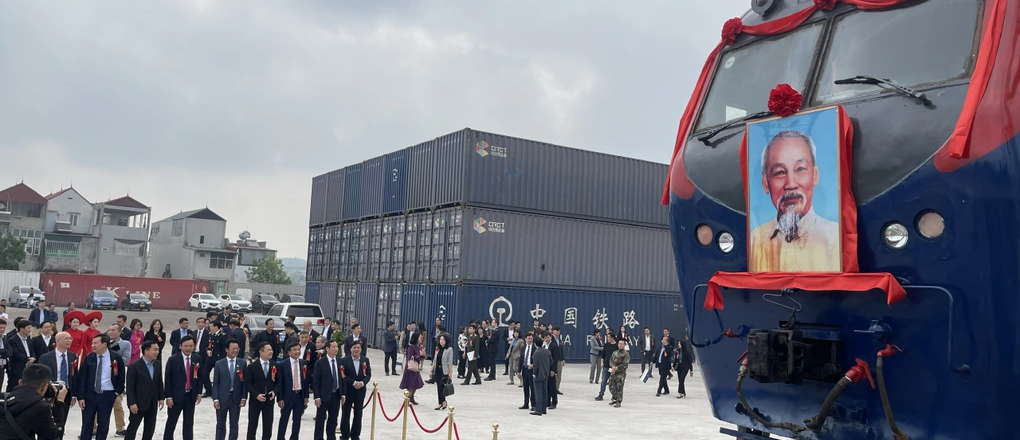The railway connection between Vietnam and China is currently poised for significant development, contributing substantially to boosting trade between the two nations. Mr. Nguyen Hoang Thanh, Deputy General Director of Ratraco (the unit responsible for operating the intermodal rail), mentioned that in previous years, Vietnam’s railcars transported about 100 railcars, equivalent to 2 trains, through a third country each month during transit.
However, in recent times, the volume of railcars has increased considerably. “Presently, when we submit plans, regardless of the quantity, you can receive all the railcars, and they can transit to any country,” stated Mr. Nguyen Hoang Thanh.
Freight transport activities by rail between Vietnam and China have been in existence for a long time, but it was only in 2017 that the first container trains traversed the border between the two countries. Currently, most intermodal trains from Vietnam follow the Dong Dang – Píngxiang route, as the rail gauge from Hanoi to Dong Dang has been upgraded to standard specifications, allowing railcars from Píngxiang to travel directly to Hanoi.
Ratraco’s Deputy General Director revealed that Vietnam is connecting its intermodal railway to China, providing access to Russia, Mongolia, Kazakhstan, Central Asian countries, and Europe. Freight transported by rail from Vietnam to China is diverse, predominantly comprising fruits, agricultural products, and ores. Conversely, China transports goods such as raw materials, consumer goods, and machinery and equipment.
Compared to other transportation methods like air and sea, rail freight falls into an intermediate segment. Although it takes longer than air travel, rail freight costs are lower, and the volume of cargo transported is larger. The rail transport time is also significantly faster than sea transport. For instance, a container transported by sea from Vietnam to Russia can take up to 45 days, while rail transport only takes 25 days. This advantage allows rail transport to penetrate deeper into the inland areas.
The role of intermodal railways becomes more prominent during the period when land border crossings between Vietnam and China face congestion due to the COVID-19 pandemic. According to Mr. Thanh, there were times when all other forms of transportation ceased operations to combat the pandemic, but only intermodal trains continued to run briskly across the border of the two countries.

The history of the Vietnam – China railway dates back to the late 19th century when French colonialists built the Hanoi – Dong Dang railway connecting to Píngxiang. The construction was completed in 1902.
The Hai Phong – Yunnan railway, spanning 855 kilometers, was built by the French with the ambition to construct a railway across treacherous mountains, connecting to Kunming. Of the total length, 390 kilometers was located on Vietnamese territory (Hai Phong – Hanoi – Lao Cai), and 465 kilometers was in Chinese territory (from Hekou to Kunming).
At the time of its inauguration, the Hai Phong – Yunnan railway became a crucial transportation hub, serving the exploitation of minerals in Northern Vietnam and facilitating trade with China. However, it also resulted in the deaths of approximately 12,000 local workers and 80 Europeans during the construction period.
Currently, from Yen Vien station (Hanoi), trains can interconnect to China through two directions: Dong Dang – Pingxiang and Lao Cai – Hekou.
In 2019, in an event showcasing Vietnam’s diplomatic intermediary role, North Korean leader Kim Jong Un took a train from Pyongyang to Dong Dang station (Lang Son) and then proceeded to Hanoi to meet with Former President of USA – Donald Trump.
In the national railway network plan for the 2021-2030 period with a vision to 2050, the keyword “China” is mentioned nine times. This plan envisions the modernization and utilization of the two railway branches through Lao Cai and Lang Son to enhance transportation efficiency.
Presently, the Hai Phong – Lao Cai – Kunming railway, which has historical significance, is under review for investment and development by the authorities of both countries.
Since 2015, China has planned to reconstruct this railway line, and the Chinese government has provided non-repayable aid to Vietnam for project surveys and planning.
The project brings benefits in both directions. Vietnam has the opportunity to upgrade its railway infrastructure, promoting imports and exports with China. Meanwhile, goods from the southern provinces of China have the opportunity to access the international port of Hai Phong, which is much closer than the eastern ports of China.
In the case of China providing capital and technology for the project, the balance of benefits between the two sides may determine the level of preferential treatment Vietnam receives.

Recently, the Ministry of Transport has assigned the Project Management Unit (PMU) of the Railway to organize a feasibility study report on the investment project to build the Lao Cai – Hanoi – Hai Phong railway line.
On November 30th, during a meeting with the Secretary-General of the National Development and Reform Commission of China, Deputy Minister of Transport Nguyen Danh Huy affirmed, “The senior leadership of both countries has a shared and clear understanding, issuing a joint statement on cooperation to promote the implementation of several railway lines in Northern Vietnam connecting with China.”
In December, the theme of strengthening the connection of railway transportation infrastructure continued to be discussed in the meeting between Minister of Foreign Affairs Bui Thanh Son and his Chinese counterpart Wang Yi.
The national railway network plan identifies the Lao Cai – Hanoi – Hai Phong line as approximately 380 kilometers long, connecting from Lao Cai to the South Hai Phong station. The trains will run on a double track, electrified. The investment route is planned until 2030 and beyond 2030.
Source: dantri.com.vn


